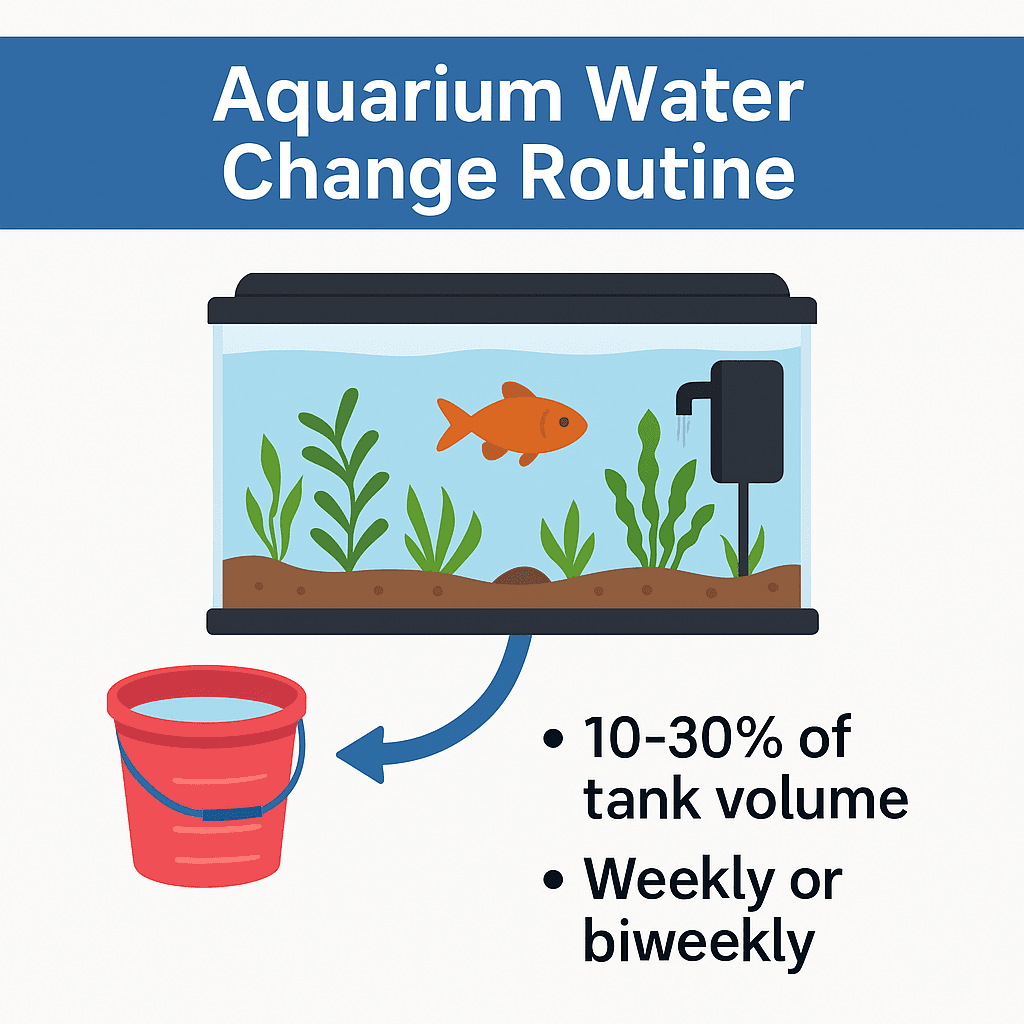
💧 Aquarium Water Change Routine – How Often Should You Change Water?
Water changes are one of the most important — yet misunderstood — tasks in aquarium keeping. They’re not just about removing dirt; they’re about resetting the tank’s chemistry, replenishing vital nutrients, and giving your fish, shrimp, and plants the clean, balanced environment they need to thrive.
This guide breaks down how often to change aquarium water based on tank size, stocking level, filtration, and plant density — plus exactly how much to change and the best methods for both beginner and advanced setups.
🌊 Why Water Changes Matter
- Removes nitrate buildup from fish waste and decay
- Replenishes essential minerals for livestock and plants
- Stabilizes pH, KH, and GH over time
- Improves oxygenation and water clarity
- Prevents algae by reducing excess nutrients
📏 How Much Water Should You Change?
The “right” amount depends on your tank’s size, bioload (how many fish), and how well it’s filtered and planted. Here’s a general guideline:
| Tank Type | Water Change % | Frequency |
|---|---|---|
| Lightly stocked, planted (low tech) | 15–20% | Every 1–2 weeks |
| Moderately stocked community tank | 25–30% | Weekly |
| Heavily stocked or breeding tank | 30–50% | Weekly or 2x/week |
| Unfiltered betta/shrimp bowl | 50–70% | 2–3x per week |
| High-tech CO₂ planted tank | 30–50% | Weekly |
| Nano tanks (5g or less) | 25–50% | 2x per week |
📌 Freshwater Tank Size Water Change Chart
Here’s a quick reference for common freshwater tank sizes:
| Tank Size | Suggested Change | Schedule |
|---|---|---|
| 5 Gallon | 1.5–2.5 gallons (30–50%) | 2x per week |
| 10 Gallon | 2–3 gallons | Weekly |
| 20 Gallon | 4–6 gallons | Weekly |
| 29 Gallon | 6–9 gallons | Weekly |
| 40 Gallon | 8–12 gallons | Weekly |
| 55+ Gallon | 10–15 gallons or more | Weekly or biweekly |
🧪 What to Test Before and After Water Changes
- Ammonia – Should always be 0
- Nitrite – Should always be 0
- Nitrate – Ideal range: 10–40 ppm (under 20 for shrimp)
- pH – Check for sudden drops
- KH/GH – Monitor in softwater tanks or shrimp setups
🚿 Step-by-Step Water Change Process
- 1. Prep your tools: Gravel vacuum, bucket, dechlorinator, sponge or algae scraper
- 2. Clean glass: Use algae pad or magnetic cleaner
- 3. Siphon water: Remove waste from substrate (unless sand cap)
- 4. Refill slowly: Use dechlorinated tap or remineralized RO/DI water
- 5. Dose conditioner: Seachem Prime or Fritz Complete
- 6. Observe livestock: Look for stress, gasping, or erratic behavior
🧼 Water Change Tips for Planted Tanks
- Don’t vacuum the entire substrate — leave roots intact
- Top off with RO/DI or distilled if using a high-tech setup
- Match temperature carefully — sudden shifts shock plants
- Use root tabs or dose after water change to prevent nutrient loss
🐟 Water Change Tips for Fish-Only Tanks
- Feed lightly before or after the change
- Never replace all the water unless in a crash scenario
- Rinse filters in removed tank water (not tap water)
- Keep your schedule consistent to avoid parameter swings
🧪 Water Change Tips for Shrimp & Nano Tanks
- Change smaller amounts more frequently (10–20% every 2–3 days)
- Drip-acclimate if large changes are needed
- Remineralize RO water using shrimp-specific GH+ boosters
- Keep TDS, GH, and KH within species range (Cherry vs Caridina)
🧂 Saltwater & Reef Water Change Notes
While this guide is focused on freshwater, reef tanks benefit from water changes to maintain calcium, magnesium, and alkalinity — especially in tanks without dosing systems.
- Mix saltwater 12–24 hours in advance (use a powerhead and heater)
- Target 10–15% weekly for nano reefs, 20–25% for larger LPS/SPS setups
- Test salinity before and after with a refractometer
- Use RO/DI water only — never tap!
❌ Common Water Change Mistakes
- Changing too much water at once (can shock livestock)
- Using tap water without conditioner
- Adding cold water too quickly
- Over-cleaning the substrate or filter media
- Skipping changes for weeks due to clear water (invisible waste builds up!)
📋 Aquarium Water Change Tracking Template
Use a journal, phone app (like Aquarium Note, Seneye, or AqDiary), or a printable chart to track:
- Date of change
- Amount removed
- Parameters before and after
- Notes on fish behavior or plant growth
- When filters or lights were last cleaned
🔗 Related Tank Health Guides
- Routine Aquarium Maintenance
- GH and TDS Testing Guide
- Troubleshooting Plant Growth
- Emergency Kit Supplies for Fish Tanks
📌 Final Thoughts – Small Changes Make Big Impact
Consistent water changes are one of the simplest — and most powerful — things you can do to maintain a healthy aquarium. Don’t wait for algae, cloudy water, or sick fish to start. Even just 15–20% per week can reset your water chemistry, remove harmful waste, and support a balanced ecosystem that’s a joy to care for.
Have a unique setup or water source? Drop your tank size and livestock in the comments and I’ll help you fine-tune your water change routine!